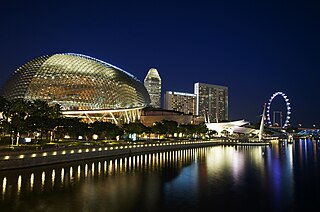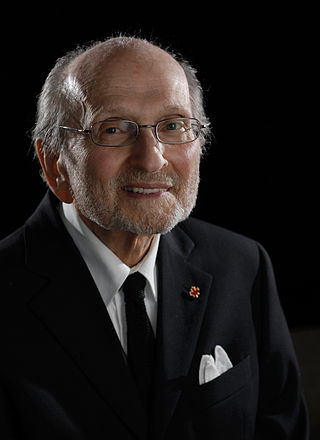
The University of British Columbia (UBC) is a public research university with campuses near Vancouver and in Kelowna. Established in 1908, it is the oldest university in British Columbia. With an annual research budget of $759 million, UBC funds over 8,000 projects a year.

Symphony Hall is a 2,262 seat concert venue in Birmingham, England. It was officially opened by Queen Elizabeth II on 12 June 1991, although it had been in use since 15 April 1991. It is home to the City of Birmingham Symphony Orchestra and hosts around 270 events a year. It was completed at a cost of £30 million. The hall's interior is modelled on the Musikverein in Vienna and the Concertgebouw in Amsterdam. The venue, managed alongside Town Hall, presents a programme of jazz, world, folk, rock, pop and classical concerts, organ recitals, spoken word, dance, comedy, educational and community performances, and is also used for conferences and business events as part of the International Convention Centre.

The Morton H. Meyerson Symphony Center is a concert hall located in the Arts District of downtown Dallas, Texas (USA). Ranked one of the world's greatest orchestra halls, it was designed by architect I. M. Pei and acoustician Russell Johnson's Artec Consultants, Inc. The structural engineers for this project was Leslie E. Robertson Associates, and opened in September 1989.

Green College is a centre for interdisciplinary scholarship and a community of scholars at the University of British Columbia founded by Cecil Howard Green and Ida Green.

Bing Wing Thom, was a Canadian architect and urban designer. Born in Hong Kong, he immigrated to Vancouver, British Columbia, Canada with his family in 1950. His paternal grandfather originally immigrated to Vancouver in the 1890s and his father was born in New Westminster before moving to Hong Kong after being unable to practice as a pharmacist in Canada.

Centennial Concert Hall is a 2,305-seat performing arts centre located at 555 Main Street in downtown Winnipeg, Manitoba, Canada, as part of the Manitoba Centennial Centre. The concert hall opened on March 25, 1968.

The Hexagon is a multi-purpose theatre and arts venue in Reading, Berkshire, England. Built in 1977 in the shape of an elongated hexagon, the theatre is operated by Reading Borough Council under the name "Reading Arts and Venues" along with South Street Arts Centre and Reading's concert hall.

Dr. Phillips Center for the Performing Arts is a performing arts center in Downtown Orlando, Florida, United States. It joined the Bob Carr Theater, which originally opened as the Orlando Municipal Auditorium in 1927, to become Orlando's main performance venue. The center's grand opening was held on November 6, 2014.

The M Telus is a performing arts centre in Montreal, Quebec, Canada. It is located in the central part of the downtown core, on Saint Catherine Street East between Saint-Dominique and De Bullion Streets, in the Quartier des Spectacles. The hall primarily features rock music groups, and is a venue for several festivals, including the Montreal International Jazz Festival and the FrancoFolies de Montréal.

The Barbican Centre is a performing arts centre in the Barbican Estate of the City of London, England, and the largest of its kind in Europe. The centre hosts classical and contemporary music concerts, theatre performances, film screenings and art exhibitions. It also houses a library, three restaurants, and a conservatory. The Barbican Centre is a member of the Global Cultural Districts Network.

The Palladium at the Center for the Performing Arts is 1,500-seat, 151,000-square-foot (14,000 m2) concert hall located in Carmel, Indiana.
Frederick Russell Johnson was an architect and acoustical expert. Johnson was the founder of Artec Consultants Incorporated in 1970. Nicknamed the "guardian of the ear" by Jean Nouvel in 1998 and an "acoustic guru" by others, Johnson was best known for works that included technical designs for the Morton H. Meyerson Symphony Center in Dallas, Texas, Jazz at Lincoln Center in New York, New Jersey Performing Arts Center, Centre in the Square in Canada, Pikes Peak Center in Colorado, Chan Centre for the Performing Arts in Canada and the Kravis Center for the Performing Arts in Florida.

Artec Consultants Inc, is an acoustics design and theater planning firm located in New York City. The company was founded by Frederick Russell Johnson in 1970. In 2013, Artec was integrated into the acoustic design and theater consulting practice Arup Group.
The Surrey City Centre Library is the main branch of Surrey Libraries. It was opened in September 2011 and replaced the Whalley Public Library. Part of a re-vitalization project for the City Centre area, the building was designed by Bing Thom. The library is located northwest of Surrey Central station in the Whalley / City Centre neighbourhood.
Nagata Acoustics is an international acoustical consultancy firm. In Japan they have been involved in the design of over seventy concert halls, including the Suntory Hall, Sapporo Concert Hall, Muza Kawasaki Symphony Hall, Kyoto Concert Hall and Hyogo Performing Arts Center; other projects have included the Supreme Court, Tokyo and the sound system for the New National Theatre, Tokyo. Outside Japan they have consulted on the Walt Disney Concert Hall, Polish National Radio Symphony Orchestra in Katowice, the Danish Radio Concert Hall, Helsinki Music Centre, Mariinsky Concert Hall and Opera House, Elbphilharmonie, Taichung Metropolitan Opera House, Bing Concert Hall, and Philharmonie de Paris.
The vineyard style is a design of a concert hall where the seating surrounds the stage, rising up in serried rows in the manner of the sloping terraces of a vineyard. It may be contrasted with the shoebox style, which has a rectangular auditorium and a stage at one end. Other possibilities are the fan-shaped and the arena. The design might be considered a musical theatre in the round.
Caleb Chan is a Hong Kong-born Canadian businessman and philanthropist. He is the chairman and chief executive officer of the International Land Group in San Francisco and of Burrard International Holdings in Vancouver.

The architecture of Vancouver and the Greater Vancouver area consists of a variety of modern architectural styles, such as the 20th-century Edwardian and the 21st-century modernist styles. Initially, the city architects embraced styles developed in Europe and the United States, with only limited local variation.

Abraham Jedidiah Rogatnick was an American-born Canadian architect and professor.

The University of British Columbia's (UBC) Point Grey Campus is the main campus of the university. It is located on the Point Grey peninsula in British Columbia, Canada. It is home to close to 55,000 undergraduate and graduate students. The 402-hectare (993-acre) campus is also home to a numerous residential housing developments that were built by UBC in conjunction with private developers.


















